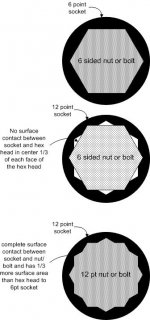We all know that both hex points and bi-hex points socket can be applied on hex nut, two of the differences are convenience and torque. more points mean more angles could slide onto hex nut, literally bi-hex socket are made with double number of points than hex socket, which is easily fit onto hex nut especially when it is applied in confined spaces. In other words bi-hex can fit onto hex nut with only 30 degree, this feature is quite a both time and labor savor.
While hex socket have better torque performance and preventing nut corner from wearing than bi-hex one, two reasons as following:
1) The flank thickness of hex socket is thicker than bi-hex one, torque can be evenly applied on each side of the hex nut.
2.) Torque power load on flank of nut or bolt instead of corners

As we can see, hex socket are made with better torque performance than bi-hex type sockets, why later is popular?
One of the reasons is scaffolers and workers would use podger ratchets daily and monthly, so they need a tool which can be both time savor and labor savor, thus bi-hex goes beyond than hex.
At last, I prefer Bi-hex, whether podger or swingover spanner.
